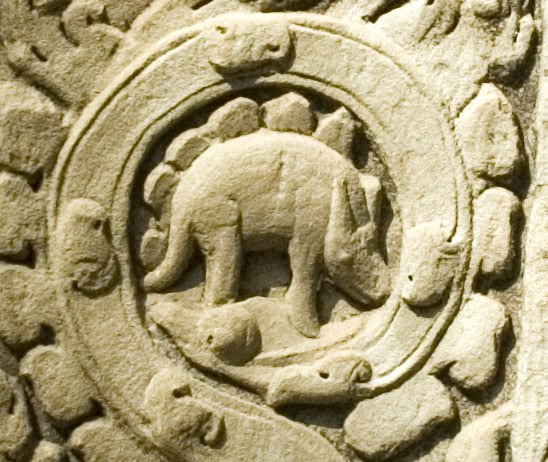It looks like you're using an Ad Blocker.
Please white-list or disable AboveTopSecret.com in your ad-blocking tool.
Thank you.
Some features of ATS will be disabled while you continue to use an ad-blocker.
share:
reply to post by Akragon
well they aint so massive that they could not be handled with good old rollers, ramps, and ropes. the stone is fairly soft as stone goes, they are possibly limestone which is extremely easily carved by pecking with the much harder flint, flaked at an edge for sharpness (anything under a ninety degree edge would work on the flint to quickly make an impression on the limestone or a similarly softish rock) . i could teach you to carve it in all of five mins if we had a 1-1 tuition session, and i'm no mason, i just love hanging out in woods doing grimy stuff with rocks and that
well they aint so massive that they could not be handled with good old rollers, ramps, and ropes. the stone is fairly soft as stone goes, they are possibly limestone which is extremely easily carved by pecking with the much harder flint, flaked at an edge for sharpness (anything under a ninety degree edge would work on the flint to quickly make an impression on the limestone or a similarly softish rock) . i could teach you to carve it in all of five mins if we had a 1-1 tuition session, and i'm no mason, i just love hanging out in woods doing grimy stuff with rocks and that
reply to post by Akragon

This picture is really Australian aboriginal rock art.
www.gondwananet.com...
www.gondwananet.com...
www.google.com.au...
So how did you link this to Gobekli Tepe?
I think you need to check a map because Australia is thousands of kilometres from Turkey.
If this is your serious with humour, then your are just ruining decent topics with fraudulent misrepresentation of information & cause yourself to look foolish.
This one is puzzling... the image on the upper right side is almost alien... Maybe... just maybe, its proof of the existence of some sort of fairy species?

This picture is really Australian aboriginal rock art.
www.gondwananet.com...
www.gondwananet.com...
www.google.com.au...
So how did you link this to Gobekli Tepe?
I think you need to check a map because Australia is thousands of kilometres from Turkey.
Originally posted by Akragon
Serious with a shade of humour...
that's kinda my style...
If this is your serious with humour, then your are just ruining decent topics with fraudulent misrepresentation of information & cause yourself to look foolish.
edit on 25-4-2013 by acrux because: (no reason given)
reply to post by acrux
Apparently its against the rules to make ones self look foolish?
Or make mistakes?
Pardon me your perfectness... my google was on fire...
It must have malfunctioned...
Apparently its against the rules to make ones self look foolish?
Or make mistakes?
Pardon me your perfectness... my google was on fire...
It must have malfunctioned...
believe it or not, i dont come to ATS to by a cynical skeptical debunker but...
Hiya, i dont know if you have ever seen a stegosaurus's skeleton, or looked at illustrations of them drawn by folk who have evidence and stuff, but the Angkor Wat Stegosaurus is hilariously un-Stegosaurus like. It's a Sumatran Rhino, with confusing decoration behind it, most likely a jungle scene.. some links
www.museumofhoaxes.com...
blogs.smithsonianmag.com...
www.stupiddinosaurlies.org...
a stegosaurus.....
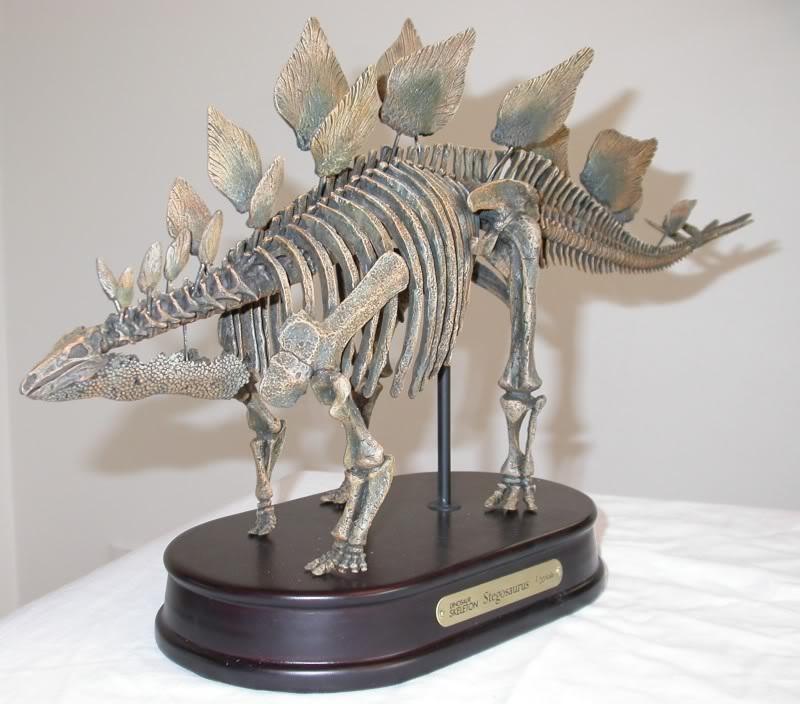
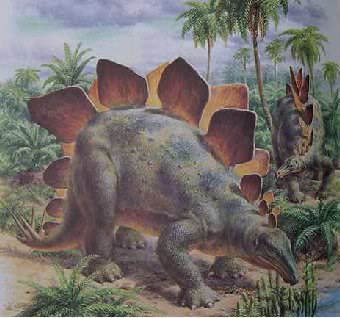
Originally posted by purplemer
reply to post by Akragon
Stegosaurus Angkor Wat....
Hiya, i dont know if you have ever seen a stegosaurus's skeleton, or looked at illustrations of them drawn by folk who have evidence and stuff, but the Angkor Wat Stegosaurus is hilariously un-Stegosaurus like. It's a Sumatran Rhino, with confusing decoration behind it, most likely a jungle scene.. some links
www.museumofhoaxes.com...
blogs.smithsonianmag.com...
www.stupiddinosaurlies.org...
a stegosaurus.....


edit on 25-4-2013 by skalla because: first line
reply to post by skalla
Hello Skalla
I do not think it's a Sumatran Rhino, with confusing decoration behind it. Ifyou look at the rest of the rock motif the idea that it is decoration is not in keeping. It really does not look like a Rhino to me
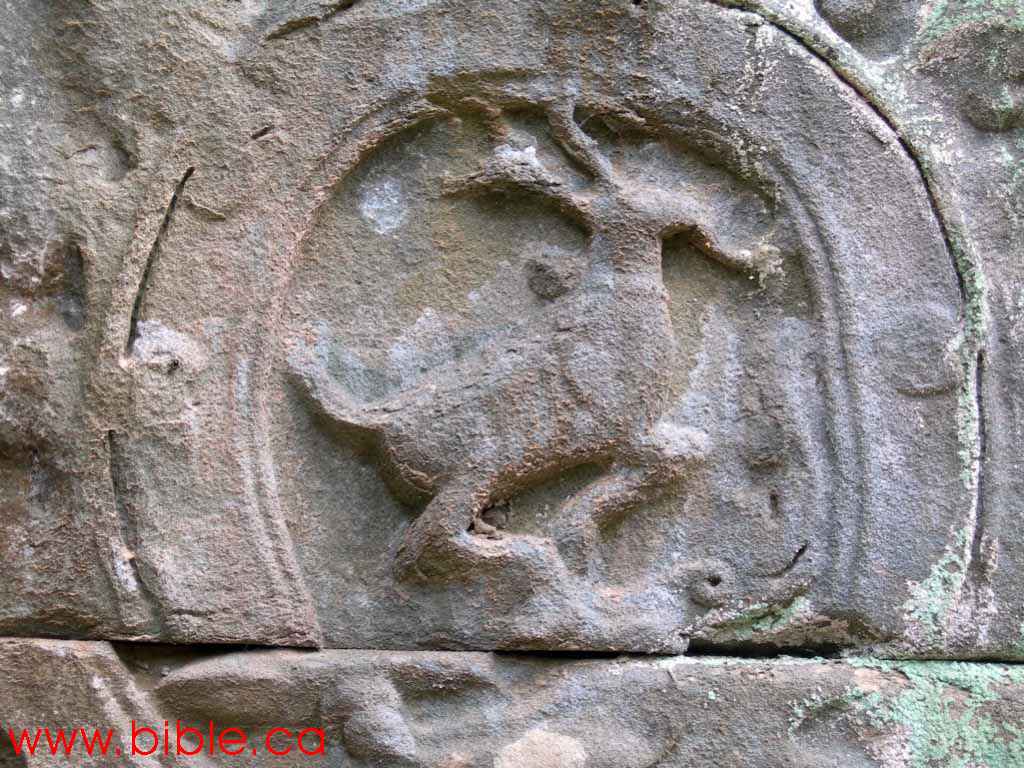
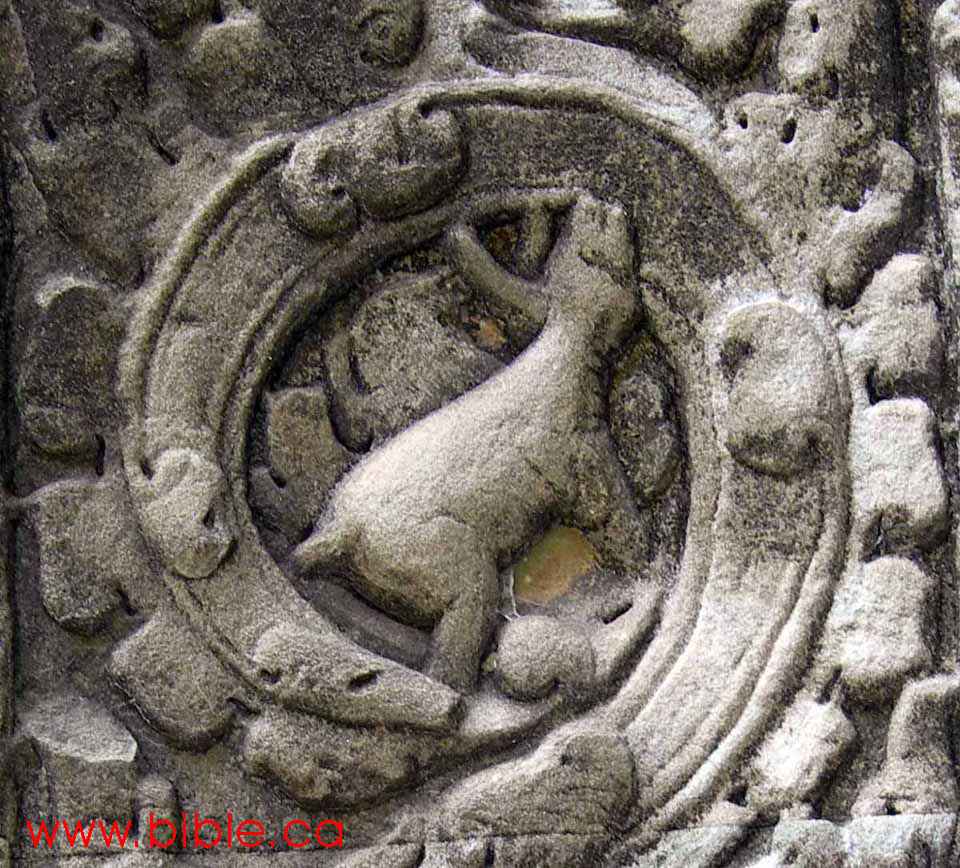
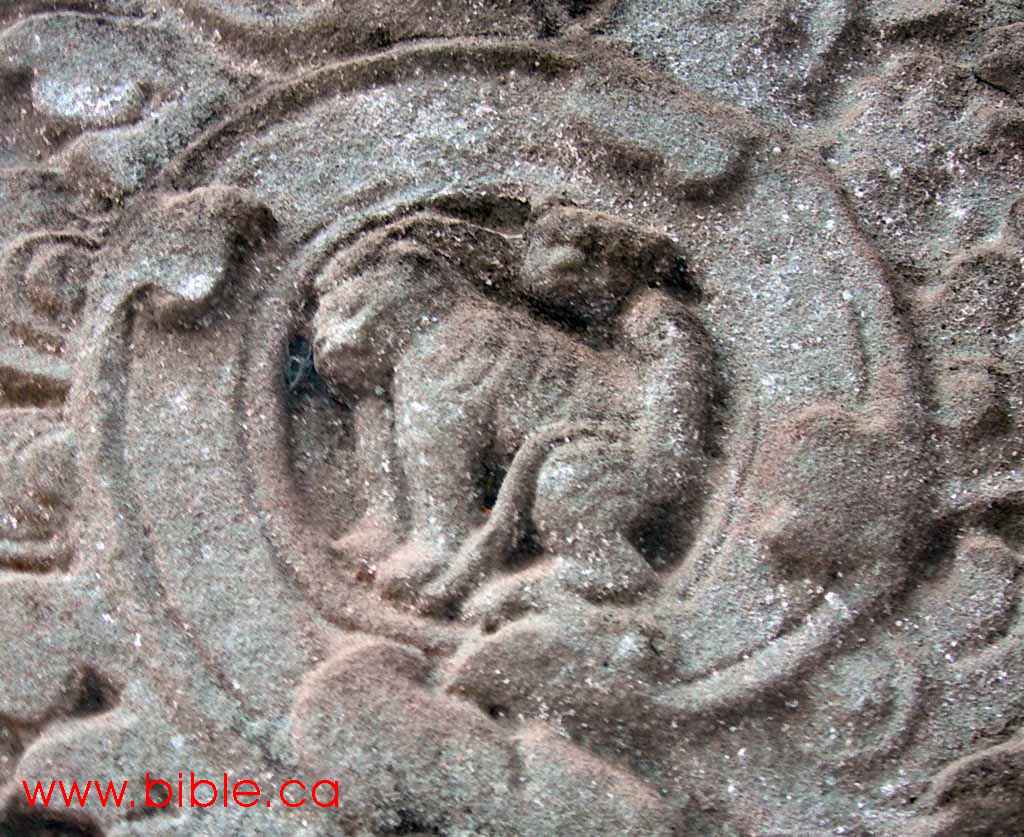
purp...
Hello Skalla
I do not think it's a Sumatran Rhino, with confusing decoration behind it. Ifyou look at the rest of the rock motif the idea that it is decoration is not in keeping. It really does not look like a Rhino to me



purp...
I would say the cat is probably pregnant. As for the bear, it reminds me more of a hyena with those stripes. But who knows?
double post
edit on 25-4-2013 by cointree77 because: (no reason given)
reply to post by purplemer
Thing is we know what stegosauri (?-uses, idk) looked like as we have plenty skeletons and analysis of them which is quite reliable.... i dont know a heap about the Angkor Wat carving, but i know enough about each to confidently dismiss the dinosaur hypothesis..
the shape of the "plates" is way wrong..the head is the wrong shape entirely and has no beaky pointy bit... it has ears.. it has a droopy tail.. the height of the legs is all wrong, and so is the straightness and jointing structure of the fore leg.
if this is a stegosaurus then the artist never ever saw one.
the deer is most realistic, why not the "dinosaur"?
i'm really not an all round sceptic, i'm just looking closely at pics of both with a critical eye
apologies for the derailment OP
Thing is we know what stegosauri (?-uses, idk) looked like as we have plenty skeletons and analysis of them which is quite reliable.... i dont know a heap about the Angkor Wat carving, but i know enough about each to confidently dismiss the dinosaur hypothesis..
the shape of the "plates" is way wrong..the head is the wrong shape entirely and has no beaky pointy bit... it has ears.. it has a droopy tail.. the height of the legs is all wrong, and so is the straightness and jointing structure of the fore leg.
if this is a stegosaurus then the artist never ever saw one.
the deer is most realistic, why not the "dinosaur"?
i'm really not an all round sceptic, i'm just looking closely at pics of both with a critical eye
apologies for the derailment OP
edit on 25-4-2013 by skalla because: typos
edit on 25-4-2013 by skalla because:
clarity
Originally posted by cointree77
I would say the cat is probably pregnant. As for the bear, it reminds me more of a hyena with those stripes. But who knows?
did you miss the cat's junk, it's a bit of a weiner so it's understandable
reply to post by Akragon
There is a quite amazing correllation in the very first pic of the op... observe the human figure and the item it is holding.
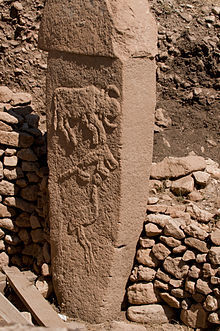
this is a "ritual" item, the use of which has survived for thousands of years... i discussed it briefly in this thread
www.abovetopsecret.com...
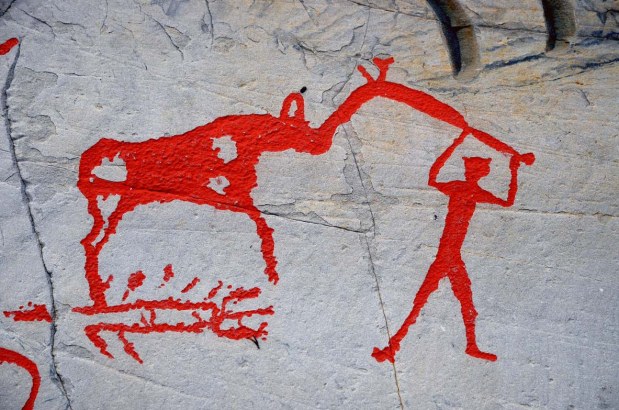
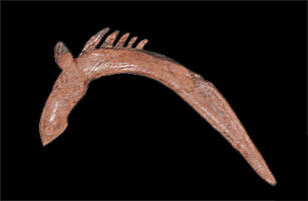
The Elk head pole is approx 7500 years old, and from scandinavia, the rock art is around 6000 years old
per-storemyr.net...
now that's pretty awesome, huh?
ETA...hmmm, second thought, is that figure human?? is it even holding the item or is the item a creature... the more i look at it the less i am sure.. any thoughts folks?
2nd ETA.... changing my mind i think, i've enjoyed my solo speculation though
There is a quite amazing correllation in the very first pic of the op... observe the human figure and the item it is holding.

this is a "ritual" item, the use of which has survived for thousands of years... i discussed it briefly in this thread
www.abovetopsecret.com...


The Elk head pole is approx 7500 years old, and from scandinavia, the rock art is around 6000 years old
per-storemyr.net...
now that's pretty awesome, huh?
edit on 25-4-2013 by skalla because: GT image
ETA...hmmm, second thought, is that figure human?? is it even holding the item or is the item a creature... the more i look at it the less i am sure.. any thoughts folks?
edit on 25-4-2013 by skalla because: (no reason given)
2nd ETA.... changing my mind i think, i've enjoyed my solo speculation though
edit on 25-4-2013 by skalla because: (no reason
given)
reply to post by Akragon
Hey Akragon, funny thread.
My perspective would be:
1) Aurochs (rather than cattle) - length of the horns being the main clue. Also, Gobekli Tepe has been argued by some to be an early agricultural temple. The lactose enzyme started to be developed within the human gut following the domestication of cattle, which began (we currently believe) in Anatolian Turkey (ie, where Gobelki Tepe is) so it would all fit together. Cattle domestication began with Aurochs and scientists are currently involved in attempting to back breed these beasts.
Aurochs - Wikipedia
How did humans develop lactose tolerance?
2) Absolutely no idea. Kind of looks like a Sabre Toothed Tiger? Possibly some still around the Black Sea Region then?
3) Wolf. As others have already stated. Wolf-Human relationships go back a long away. Wolves were very sacred animals for Neolithic man (as evidenced by the numerous depictions of them all over the place).
4) Frog Men - all that is left of the Atlanteans doomed man-frog hybrid programme.
Hey Akragon, funny thread.
My perspective would be:
1) Aurochs (rather than cattle) - length of the horns being the main clue. Also, Gobekli Tepe has been argued by some to be an early agricultural temple. The lactose enzyme started to be developed within the human gut following the domestication of cattle, which began (we currently believe) in Anatolian Turkey (ie, where Gobelki Tepe is) so it would all fit together. Cattle domestication began with Aurochs and scientists are currently involved in attempting to back breed these beasts.
Aurochs - Wikipedia
How did humans develop lactose tolerance?
2) Absolutely no idea. Kind of looks like a Sabre Toothed Tiger? Possibly some still around the Black Sea Region then?
3) Wolf. As others have already stated. Wolf-Human relationships go back a long away. Wolves were very sacred animals for Neolithic man (as evidenced by the numerous depictions of them all over the place).
4) Frog Men - all that is left of the Atlanteans doomed man-frog hybrid programme.
reply to post by troubleshooter
I stand corrected. The Aborigines must have had a separate man-frog hybrid programme in place. Who'd have though it? The sneaky little Abo's..................
I stand corrected. The Aborigines must have had a separate man-frog hybrid programme in place. Who'd have though it? The sneaky little Abo's..................
reply to post by Akragon
Could you send those pics of the animals to my email? I'm on a school computer and it's blocking the pics on this site.
[email protected]
Could you send those pics of the animals to my email? I'm on a school computer and it's blocking the pics on this site.
[email protected]
edit on 25-4-2013 by AlchemicalParadox because: Forgot to put in the email
Originally posted by AlchemicalParadox
reply to post by Akragon
Could you send those pics of the animals to my email? I'm on a school computer and it's blocking the pics on this site.
[email protected]edit on 25-4-2013 by AlchemicalParadox because: Forgot to put in the email
IF I knew how to do that I would... perhaps we can rely on one of our fellow members to help you out there...
It used to be taboo to claim that civilizations have existed prior to a few thousand years BC. Maybe it still is, I dunno, but academia I think is
slowly opening up to the fact that civilizations existed long before they were initially thought to have existed. It is obvious with what is known now
that the Sphinx in Egypt is probably 10,000 years old or so, give or take a couple of thousand years. So I would be willing to say that people were
living in what for them would be considered advanced societies at the time the last glacial maximum period ended. If this is the case, which I'm sure
it is, then these people could have interacted or seen many of the large mammals that went extinct at this time, which if I remember correctly is
known as the Quaternary extinction event. Might want to double check that though.
Personally I think some of those carvings look very similar to modern animals though, so it is hard to say. A couple look really strange, but I am not sure what they are, since more than one animal could fit the description. Part of the problem is that we do not know how good of an artist the carver was. Maybe they could carve well, but they sucked at drawing animals, lol. So it is hard for me to form an opinion at this point.
Personally I think some of those carvings look very similar to modern animals though, so it is hard to say. A couple look really strange, but I am not sure what they are, since more than one animal could fit the description. Part of the problem is that we do not know how good of an artist the carver was. Maybe they could carve well, but they sucked at drawing animals, lol. So it is hard for me to form an opinion at this point.
reply to post by JiggyPotamus
it's worth noting that as far as we know so far, GT was built by neolithic hunter gatherers and does not fit the terms for what we call "civilisation".... it's an amazing site for sure and i fully expect some amazing findings and interpretations from here in the future, but it looks as though this is pre-civilisation. many great things have been built by so called "un-civilised" folk, civil relating to cities and such.
it's worth noting that as far as we know so far, GT was built by neolithic hunter gatherers and does not fit the terms for what we call "civilisation".... it's an amazing site for sure and i fully expect some amazing findings and interpretations from here in the future, but it looks as though this is pre-civilisation. many great things have been built by so called "un-civilised" folk, civil relating to cities and such.
Originally posted by Akragon
Norse and Celtic people 12000 years ago, in Turkey?
that sounds a little odd...
The last picture, the composite with 4 pictures, doesn't really have anything to do with the topic; it's four examples from Pictish rock art from ~500-900 AD.
While there is a 'celtic' connection to Turkey, it's much later than Gobekli. See Galatia and the Galatian language.
Also, Pictish culture and language isn't celtic. The origins are not much agreed upon, but that much is known. It's only 'celtic' now in a present day layman's sort of use of the term celtic for all the historical culture of the area.
Gobekli predates the existence of Celtic language, culture, and people in pretty much every way you can think of. Cattle domestication(goes with Celtic culture) is probably just beginning at places like Gobekli. Northern Europe is still mostly under glaciers or just recently uncovered, so few people live there at all. Sea level is still low enough that Britain is still connected to the European mainland (till ~5000 BCE) and so is Ireland even (till ~9000 BCE). Blue eyes probably don't even exist yet; they are thought to go back to somewhere in the 6K-10K BCE range, and their proliferation may be connected to the spread of dairy cattle.
Google's reverse image search is your friend. Drag any image into google image search, even from another web page in a seperate tab, and it will find you other examples of the same image.
It seems you probably just grabbed an image from a google image search without reading up on the context? This blog article compares the same composite image of Pictish symbols you posted to images from Gobekli Tepe:
whiteknightstudio.blogspot.com...
So because of that article you would have found it with a simple image search, but it was not an example of something from Gobekli even according to the source that posted it; it was just something they were using for comparison.
They jump to the conclusion that they were made by the same culture. I would not conclude that at all. They don't seem so similar to me, and they are also obviously separated by 10,000ish years. The Pictish stones are from the 6th through 9th century. In the case of whole Pictish stones like the 2nd and 3rd from the left, they are possibly something very different and special indeed; they are possibly even some clever visual language with a message hidden in plain sight for somebody who knew how to read it:
news.discovery.com...
www.decodedscience.com...
(1st link more of an overview, second link has a bit more meat to it)
edit on 26-4-2013 by 11andrew34 because: typo
edit on 26-4-2013 by 11andrew34 because: added a link
edit on
26-4-2013 by 11andrew34 because: fixed a link
reply to post by Akragon
"I was recently watching a documentary on Gobekli Tepe... which is an ancient Neolithic sanctuary discovered in 1994 by an old Kurdish shepherd in Turkey."
I believe it is actually pre-Neolithic, if I am not mistaken, from the hunter-gatherer period. That means that it goes back before agriculture, much like the cave paintings. How fascinating!
Did Shamans use these pictures in a belief that they were mental technologies to attract game?
"I was recently watching a documentary on Gobekli Tepe... which is an ancient Neolithic sanctuary discovered in 1994 by an old Kurdish shepherd in Turkey."
I believe it is actually pre-Neolithic, if I am not mistaken, from the hunter-gatherer period. That means that it goes back before agriculture, much like the cave paintings. How fascinating!
Did Shamans use these pictures in a belief that they were mental technologies to attract game?
new topics
-
The trial on kids was stopped
Medical Issues & Conspiracies: 19 minutes ago -
Orbs Appear And Form Triangle On Live Cam.
Aliens and UFOs: 2 hours ago -
Biden Has New Bizarre Injuries to His Face
Politicians & People: 3 hours ago -
Something is not adding up in regards to the H-1B commotion
General Conspiracies: 3 hours ago -
Elon Musk Calls for Tommy Robinson to be Freed - and Takes a Dig at Starmer
Politicians & People: 4 hours ago -
Biden to award Presidential Citizens Medal to Liz Cheney and Bennie Thompson
US Political Madness: 4 hours ago -
Just learned a really helpful trick for internet searches
Computer Help: 10 hours ago
top topics
-
Biden Has New Bizarre Injuries to His Face
Politicians & People: 3 hours ago, 9 flags -
Biden to award Presidential Citizens Medal to Liz Cheney and Bennie Thompson
US Political Madness: 4 hours ago, 8 flags -
Just learned a really helpful trick for internet searches
Computer Help: 10 hours ago, 7 flags -
Not off to a good start
General Chit Chat: 12 hours ago, 6 flags -
Elon Musk Calls for Tommy Robinson to be Freed - and Takes a Dig at Starmer
Politicians & People: 4 hours ago, 5 flags -
Something is not adding up in regards to the H-1B commotion
General Conspiracies: 3 hours ago, 5 flags -
Orbs Appear And Form Triangle On Live Cam.
Aliens and UFOs: 2 hours ago, 3 flags -
The trial on kids was stopped
Medical Issues & Conspiracies: 19 minutes ago, 2 flags
active topics
-
Vehicle Strikes people in New Orleans
Mainstream News • 275 • : WeMustCare -
How we've changed in 100 years
Ancient & Lost Civilizations • 33 • : KrustyKrab -
Tesla Cybertruck Explodes in Front of Trump Hotel in Las Vegas
Mainstream News • 111 • : Flyingclaydisk -
The trial on kids was stopped
Medical Issues & Conspiracies • 0 • : annonentity -
-@TH3WH17ERABB17- -Q- ---TIME TO SHOW THE WORLD--- -Part- --44--
Dissecting Disinformation • 3895 • : IndieA -
Strange fog all over the northern hemisphere
General Conspiracies • 43 • : annonentity -
The Acronym Game .. Pt.4
General Chit Chat • 1033 • : tinkerbell99 -
Ukraine halts transit of Russian gas to Europe after a prewar deal expired
Political Conspiracies • 111 • : Oldcarpy2 -
Post A Funny (T&C Friendly) Pic Part IV: The LOL awakens!
General Chit Chat • 7979 • : chiefsmom -
Biden Has New Bizarre Injuries to His Face
Politicians & People • 9 • : CarlLaFong

